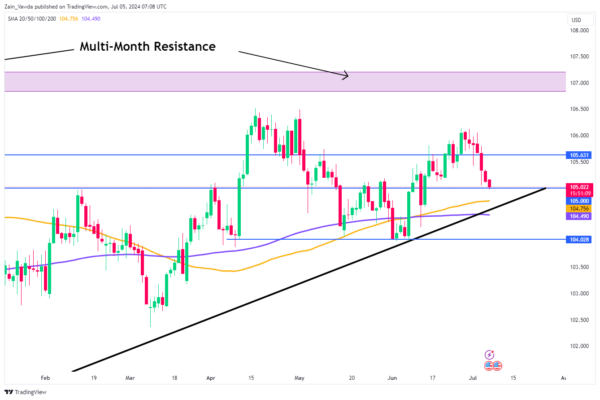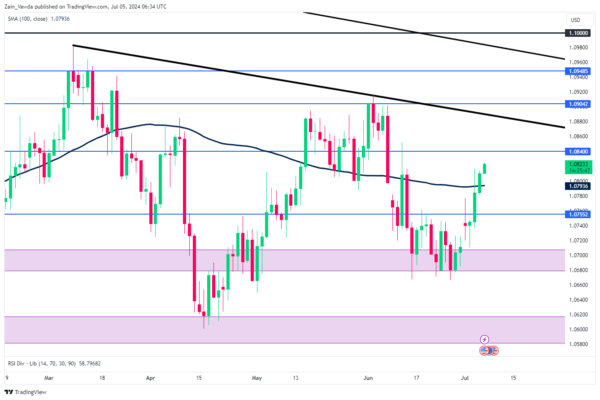- EUR/USD rises above 1.0800 due to weak US economic data and a weaker USD.
- Market anticipates a 71.6% chance of a rate cut in September.
- DXY is at a psychological support level ahead of US jobs data release.
EUR/USD continued its upward momentum on US Independence Day, capitalizing on a weaker USD and low market liquidity to rise above the 1.0800 level.
A series of weak US economic data this week has increased expectations for rate cuts. ISM services data disappointed yesterday, contracting at its fastest rate in four years.
The ADP job numbers also came with a warning from ADP Chief Economist Nela Richardson, who noted that job growth had not been widespread. The leisure and hospitality sectors bolstered the ADP figure, which is unsurprising given the significant rise in travel during the summer.
This data has led market participants to price in a 71.6% likelihood of a rate cut in September, up from about 60% a week and a half ago. Last night’s Fed minutes revealed no new information, with the Fed emphasizing their lack of urgency to cut rates. Can upcoming data influence the Central Bank’s decision?
US Interest Rate Probability
Source: LSEG
EU Retail Sales,US Jobs Data
Eurozone retail sales figures will be released shortly, with expectations for a 0.2% month-over-month increase and a 0.1% year-over-year rise. After the disappointing results in April, market participants are hoping that May’s numbers indicate some improvement. A positive reading could support the Euro against the US Dollar, even if the gains are temporary.
The importance of this NFP report and the unemployment rate release has been extensively discussed. After last month’s exceptional NFP figures, markets are eager to see if that result was an anomaly or part of a trend.
Technical Analysis on DXY and EUR/USD
The Dollar Index (DXY) is once again trading at a psychological support level, where numerous factors converge just ahead of tomorrow’s batch of US data. This positions the DXY delicately as we approach the release.
Should the data exceed forecasts, the DXY could retest the 106.00 level. Conversely, a disappointing data release could put the DXY at risk of breaking below the 100 and 200-day moving averages (MAs). These moving averages are situated just below psychological support and above the long-term ascending trendline.
The 100-day MA is at 104.75, with the 200-day MA slightly lower at 104.49. Combined with the trendline, the area just below 105.00 is dense with confluences. Therefore, a sustainable break below this level may be challenging unless the jobs data falls significantly short of expectations.
US Dollar Index Daily Chart, July 5, 2024
Source: TradingView.com (click to enlarge)
Key Levels to Keep an Eye on;
Support
- 105.00
- 104.75
- 104.50
- 104.00
Resistance
- 105.60
- 106.00
- 107.00
EUR/USD
EUR/USD is enjoying a bit of a renaissance following a two-week period of rangebound trading. Having finally broken above the resistance level at 1.0750, the pair has advanced and crossed above the 100-day MA.
A daily candle close above the 100-day moving average has positioned EUR/USD favorably ahead of the NFP and jobs data release in the US. Immediate resistance lies in the 1.08400-1.08500 range. A break above this level would bring the short-term descending trendline and the 1.0900 mark into play.
A significant downside miss in the NFP data could propel EUR/USD towards the psychological 1.10000 level. Conversely, if the data surpasses estimates, EUR/USD could head towards recent lows, potentially pushing beyond 1.07000 and highlighting the 1.0600 support level.
EUR/USD Daily Chart, July 5, 2024
Source: TradingView.com (click to enlarge)

















